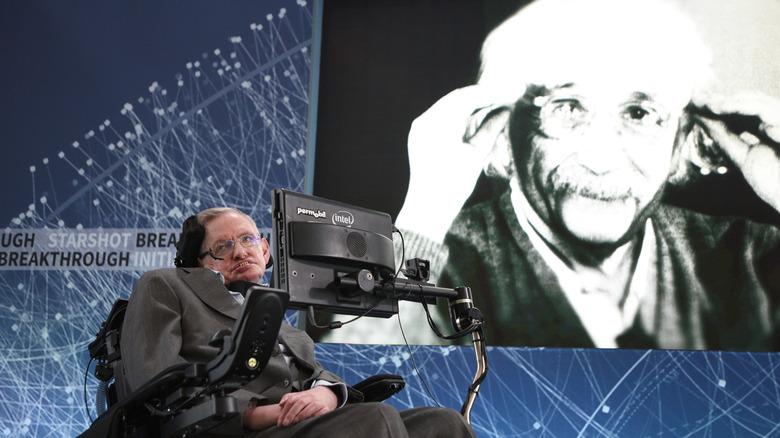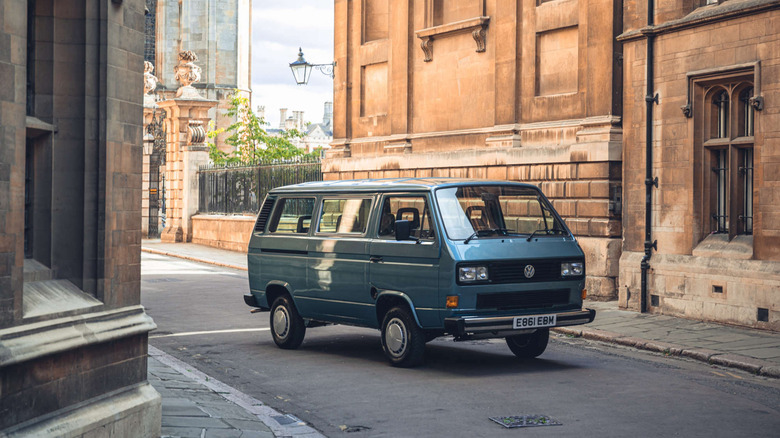Here's What Happened To Stephen Hawking's Volkswagen Van
If you're a fan of theoretical physics, general relativity, or black holes, you probably know the name Stephen Hawking. Even if you don't understand a single thing about any of those subjects, you probably recognize the man. He is one of science's Mt. Rushmore of Minds, our generation's Albert Einstein.
The British scientist first studied physics at Oxford, earning a bachelor's degree in 1962 and a doctorate in 1966 from Cambridge. Before his career as a preeminent scientist even began, his body started to fail. While at Cambridge, he began noticing that everyday tasks, like tying his shoes, got harder.
When he was just 21, an ice skating accident sent Hawking to Guy's Hospital in London, where he was found to have the motor neuron disease, Amyotrophic Lateral Sclerosis (ALS), known in the United States as Lou Gehrig's disease. Doctors gave him two years (via Stephen Hawking Foundation), but Hawking lived with the disease for 55 years, dying on March 14, 2018, at the age of 76. His ashes were placed between the graves of Charles Darwin and Sir Isaac Newton at Westminster Abbey.
In 1988, his seminal cosmology book for dummies, "A Brief History of Time," was published. It's also the year he bought a new Volkswagen Caravelle GL 112. At least, that's what they called it in Europe. Here in the United States, it was known as the "Vanagon," a third-gen version of VW's iconic microbus that first hit the roads in 1950. Fun fact: the microbus was the second vehicle built by the German car maker (after the Beetle).
The bus for hippies became the bus for a genius
The bus Hawking purchased had a stamped steel body, three-speed automatic transmission, and a rear-mounted, water-cooled, 2.1-liter gas engine producing 112 brake horsepower. For obvious reasons, the interior was modified to load and transport him and his motorized wheelchair safely and comfortably. It was used as his personal vehicle for over a decade and was a familiar sight on the Cambridge campus. He even used it to get to his wedding to Elaine Mason in 1995.
Over the years, his condition worsened, and, in 1999, he was forced to give up the Caravelle when he needed a new wheelchair — one the tried and true Volkswagen could no longer accommodate. Hawking gave the microbus to his adopted brother, Edward Frank David, who held onto it until his own death in 2003. Edward's son, Hawking's nephew, then inherited the vehicle and kept it in the family (via Silverstone Auctions) for the next 19 years.
In August of 2022, Hawking's nephew decided to sell it because he no longer drove it, and it took up valuable space in the garage. He hoped to sell it to a fellow scientist or "Professor Hawking enthusiast" so it could be properly appreciated. The bus has approximately 90,000 miles on it, was kept in an underground garage and was regularly maintained. The nephew said he had it professionally repainted "a few years ago."
It comes with complete documentation proving Hawking's provenance, Hawking's original Cambridge campus parking permit, and the original Pioneer CD player he had put in (he was a huge Richard Wagner fan). The Volkswagen was listed on Silverstone Auctions website on August 27th (Lot Number 521) but does not appear to have sold yet.

